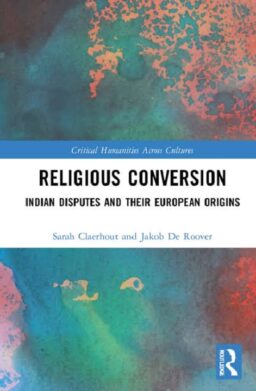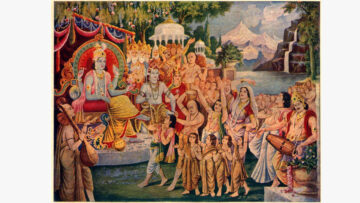INTRODUCTION
Religious conversion is a vexing problem in all plural societies, especially India, today. How can conversion ideas of accepting the ‘new’ while totally rejecting the ‘old’ apply to non-Christian, non-Islamic cultures where the concepts of belief, practice and membership are profoundly different? In India, the intellectual debates since the colonial times remain fuzzy with the problems generated by religious conversion. Why is a conversation between those who support and oppose proselytization just not possible?
Sarah Claerhout and Jakob De Roover are brilliant scholars at the Ghent University in Belgium whose articles and books clearly explicate why conversions are such a contentious issue. Typical of their school, their language, ever neutral, is easy and fluid which reaches out to not only an academician sitting in the highest University chairs but to every concerned citizen of India. It is also helpful to the westerner when attempting to study Indian culture. At the core of the Comparative Science of Cultures program initiated by the legendary S N Balagangadhara Rao, the west and the east face as equals and this makes any reading from their group illuminating without arousing angers. The present book, edited by another doyen, D Venkat Rao at the English and Foreign Languages University, Hyderabad, is no exception. The authors trace the phenomenon of religious conversion from its roots (mainly from the Christian perspective) and show how intellectuals across time grappled with the idea of religious conversions.
Balagangadhara’s core hypothesis about religions (The Heathen in His Blindness) is the first step to understand the problem. In Indian society, two groups of a different nature coexist: The Hindu, Buddhist, Sikh, and Jain traditions (evolving from a single tree broadly termed Sanatana Dharma) on the one hand; and Christianity, Islam, Judaism on the other. The former group, clumped together as ‘Hinduism’ by the Constitution, lacks all the characteristics that allow us to recognize Christianity, Islam, and Judaism as religions: a fixed body of doctrine, an ecclesiastical organization or central authority, or a single holy book. Barring a few exceptions, most intellectuals both for and against proselytization debate in the framework of three basic assumptions: Indian cultural traditions are religions; these religions are rivals; and they are rivals because ‘truth’ predicates apply to them. Problematically, these ‘common-sense’ facts are a set of claims of both theological and secularised Christianity which assumes as a first step that all cultures must have a religion.
THE PROBLEM
The ordinary citizen to the highest echelons of the parliament and judiciary debate extensively on the issue of conversions and proselytization. However, the reasons are still unclear for the passions they arouse. As the author’s write, these debates consist of a bewildering tangle of themes of varying importance:violence against Christians and Muslims; Hindu nationalism; the oppression and liberation of Dalits; upper caste concerns about losing control; the rights of minorities; the need for, and threats to, a secular state; foreign funding to Indian NGOs; attempts to undermine India’s national integrity; patriarchy and its treatment of women; the legacy of British colonial rule; the hidden agendas of missionaries; Western imperialism and its derogation of Indian culture; demographic changes in post-Independence India; the desirability or otherwise of ‘inter-religious marriages’; and so on.
Today, conversion is fundamentally a clash between the ‘Hindu nationalist’ forces on one side and the ‘secular-liberal- minorities-religious rights activists’ on the other. The former looks at ‘freedom of religion’ in the constitution as a right to practice one’s faith freely without fear of interference from missionaries pulling people away from their traditions and causing a social disruption along with weakening the majority fraudulently. For the other group, ’freedom of religion’ implies a freedom not only to choose one’s own religion but also a state protected right to convert. The ‘social’ aspect involves the argument that conversion allows an individual to move away from the oppressive caste-based and other practices in the Hindu religion. One group wants legislation to ban conversion and the other group views such legislation as a pretext for harassing Christians, Muslims, and potential converts.
The major reaction of Indian population to proselytization since 17th century to the present times has been essentially incomprehension along with anger at the need for conversion to another religion. The distinction between ‘genuine’ and ‘fraudulent’ conversions is another area of confusion. Hence, objections to missionary activity in India often focus on attempts to convert minors or the ignorant, illiterate, and uneducated. Obscurity pervades in the legislation and the intellectuals on the use of many words like ‘force’, ‘fraud’, ‘allurement’, ‘inducement’, ‘threats of divine displeasure’, ‘conversion’, ‘religion’, and ‘propagation’. The Humanities offer a limited view since they continue working on a set of assumptions concerning Indian traditions as outlined previously.
CONVERSION, REFORM, EDUCATION IN COLONIAL INDIA
Following its Charter Act of 1813, Christian missionaries, colonial officials, and orientalist scholars worked on an unprecedented scale for the purpose of conversion using direct and indirect means. The 19th century also saw intense responses by Indians against conversions. The Europeans approached Indian traditions using self-evident theological terms embedded in Christianity: idolatry, superstition, error, heathenism, gods, priests, religion, worship, etc. The Indian response was also using the same English words but without understanding the background theology leading to incoherence many times.
Missionaries wanted to convert the land of ‘idolatry and superstition’ to the true religion of Christianity. Orientalists and colonials, applying caution, attempted to show that Indian scriptures were of human origin. With immoral deities, they were incoherent, inaccurate, and thus false. A demand for ‘scientific’, ‘factual’, or ‘empirical’ proof of the divine origin of the Indian texts (especially Vedas) would dissolve the trust placed on these texts. This would prepare a fertile soil for seeing and accepting the truth of Christianity.
The vigorous Indian responses repeatedly took various forms: one religion cannot be true for whole humanity; since each is good for its practitioners with no internal conflict, there is no need for conversion; there were no clear records of Jesus Christ; the inspiration to become a Christian could only be for base desires and a lack of reflection, and so on. At times, the Indians preferred silence or simply an attitude of indifference.
What looked significant and sensible to one appeared trivial and unreasonable to the other. Prominently, there was a mutual incomprehension characteristic of the disputes about religious conversion in India. For British missionaries, officials, and orientalists, the conflicts about true religion between Catholics and Protestants in the post-Reformation era, between Christians and Jews during the Middle Ages, about heresy and apostasy formed the framework of understanding Indian traditions. However, they summarily rejected the Indian explanations because Indians could not think rationally, logically, or morally about their traditions, deities, and texts.
An important idea crystallised and seeped into Indian intellectuals too that the deficient situation of Indians was related to their ‘religion’ and needed remedy through education and reform. A range of practices and attitudes rooted in Hindu religion became immoral. A missionary debate started in the 1820s whether caste was really a civil or a religious institution. This was an intra-Christian issue formulated in terms of Christian theological conceptual distinctions between the civil (acceptable), the religious (acceptable if true; rejected if false), and the idolatrous (needing rejection). After decades of dispute, the Madras Missionary Conference of 1850 declared that caste was essentially a false religious institution and not a mere civil distinction. Thus, caste became immoral and idolatrous. Conversion entailed emancipating oneself from the hold of this religious institution and its Brahmanical oppression. This shows how Christian Europeans saw Indian culture and how many of their views became ‘facts.’
Hindus need to either reform such practices or simply convert to Christianity. Despite a strong education policy focussing on the evils of Hindu religion, conversions to Christianity did not occur at any significant scale. However, there were other results on a gradual scale which was essentially another way of approaching Indian traditions: criticism and exegesis of texts; a search for historical evidence in those texts; seeing a need for a scientific temper that should replace superstition; and so on.
All these discourses spill into the 20th and 21st century India. Today, Indian secularists and Western commentators agree that religious conversion in India is a way for Dalits or lower caste members to escape from oppressive ‘the caste system’. For Dr Ambedkar, destroying the religion of the Shrutis and Smritis was the only way to bring about a breach in the caste-system. Mutual incomprehension stays intact as one group insists on conversions as a true path and the other questions the need for conversion. On the Hindu side, both secularists and nationalists seek reform and purification of traditional practices; however, the former defend proselytization as freedom of religion while the latter opposes it.
CONVERSION IN CHRISTIAN EUROPE
As Balagangadhara’s hypothesis about religions says, Christianity spreads or ‘universalises’ itself in two ways: proselytisation (or direct conversion); and secularisation, where Christianity generalises its religious ideas in apparently ‘non-religious’ forms and leads to emergence of ‘secular’ institutions in the social world. Western culture today is a child of Christianity shaped by this twofold dynamic of religion. ‘Conversion’, a theological term, denotes the transition of an individual or group from one religious confession or denomination to another. As a next step, it refers to the internal process of transformation whereby the believer becomes a true Christian. It is here that the Christian imperative to evangelise plays a central role: as God’s revelation of His will, the Bible should come to all of humanity; the good news of salvation through Jesus Christ must reach to all people.
Medieval theologians divided the clergy and the laity as two distinct ‘estates’ within the Church. The Protestant Reformation, changing all that, viewed the Christian citizenry of their time as degenerate; the clerical institutions and its ceremonies, corrupt; and social life, depraved. The process of conversion was now for all Christians. Hence, anticlericalism took centre stage. The message of Christian spiritual freedom and freedom of conscience was central to the Protestant Reformation and one of its central charges against the Roman Catholic Church was that it had taken away this freedom and established a spiritual tyranny of the priests.
Reformation determined the way in which 19th-century British missionaries and colonial officials described Indian traditions. It strongly provided the framework for their conceptions of religion and idolatry and of the need to convert the people of India to true religion. ‘Idolatry’ was any practice identified as a human fabrication falsely presenting itself as necessary for religion. British missionaries and officials explicitly represented the traditions of ‘the Hindus’ as a ‘false religion’ full of superstition and with evil Brahmin priests indulging in false ceremonies and establishing a tyrannical ‘caste-system’. Thus, in a generic form, the Reformation’s conception of the Catholic church and society served as a model for these accounts of Indian culture and society. The need for conversion to the true God and religion was obvious.
The secular descriptions which tried to weed out the ‘secular’ from the ‘religious’ (which included ‘caste’ after plenty of debates) in Indian traditions justified the duty to reform Indian culture and society by secular education. Even those British who were not convinced Protestants or Christians embraced a framework that transformed Indians into deficient, immoral, and corrupt beings, needing reformation, education, and civilisation.
Throughout Christian history, debates about conversio required terms like: Sin, the Fall, regeneration, salvation, repentance, mercy, renewal, contrition, confession, penitence, satisfaction, the human will, grace, Christ, the Holy Spirit, righteousness, faith, charity, the need to (re)turn to God, etc. Indian conversation partners faced great difficulties in making sense of the discussed matters of ‘religion’ and ‘conversion’ since the language and the concepts used were totally alien to them. The superimposition of these terms on Indian concepts led to gross distortions from both sides. This unfortunately continues to date.
THE COHERENCE IN THE INCOHERENCE OF GANDHI
Gandhi, though appreciative of the humanitarian missionary work, spoke extensively and strongly against proselytization again expressing an incomprehension at the need for conversion. ‘Topos’ (plural ‘topoi’) refers to commonplace ideas and words which occur as clusters of interrelated ideas specific to a culture. For example, both while discussing Christian theology or in common language, the West uses words and ideas with self-evident meanings like ‘belief’, ‘faith’, ‘doctrine’, ‘conversion’, ‘religion’, and so on. ‘Conceptual distortion’ occurs when topoi originating from one cultural setting interpret topoi from another culture. Gandhi’s apparent inconsistency arose from the fact that he was adopting typical ideas and phrases from Western and Christian thinking but mapping them onto Indian settings.
Sketching Gandhi’s position, he regarded all religions as equally true. He did not accept Jesus Christ as the only son of God. Gandhi suggests that one should draw upon one’s ancestral religion and immediate religious surroundings to live a fulfilling life. One can take draw the good points from other religions surely but a conversion to another religion amounts to immorality and an unnecessary shame of one’s ancestral religion. No religion is perfect and it is important to bring reform from within (like untouchability). Conversion however meant a process of change where there is a spiritual and ethical growth.
This fundamentally clashes with the central doctrine of Christianity that Jesus Christ is God incarnate or the only son of God; Christianity is the only way for all humanity; and conversion the only method for salvation of a non-Christian. But substitute the word ‘traditions’ for ‘religion’ and suddenly there is absolute coherence in what Gandhi was describing. He was characterizing the traditions in fair detail but by trying to map the traditions of India as equivalent to religions there was a ‘conceptual distortion’.
When Gandhi speaks of ‘faiths’ or ‘religions’, he refers to the traditions of different groups or communities. ‘Religion’, consisting of the traditions of a particular community, do not have a foundation in doctrines, beliefs, or truth predicates. As ancestral practices, they provide action heuristics that instruct the individual on how to become a better human being. Traditions are thus of ‘equal value’ in providing action heuristics to pursue spiritual and moral growth. Thus, there can be a rich mutual interaction between traditions. Since each tradition has adequate resources to reform from within there is no requirement for wholesale conversion. It is thus an impossibility that one tradition can be true for all humanity.
However, there were inconsistencies too when he reproduces the typical understanding of religions as belief systems and praises Hinduism for its belief systems (oneness of all lives, transmigration of souls, varnashrama). Despite these, Gandhi had a deep understanding of Indian traditions but putting these as equivalent to religions and then using the language and ideas of Christian theology made him look incoherent when, in fact, he was not.
RELIGIOUS FREEDOM AND THE LIMITS OF PROPAGATION
For the Hindu, Jain, Sikh, and Buddhist traditions the assumption of rivalry is simply alien. Hence, in a mutually exclusive view, one looks at the diversity of the Indian society as a rivalry of religions and the other sees it as a co-existence of traditions. Thus, conversion becomes a vital problem of diversity only if one looks at the world the way Christianity and Islam do. Secularization of Christian theology translates into the importance of the absolute right to profess, propagate, and change one’s religion. However, in traditional cultures, the significance shifts to the freedom to continue one’s tradition without aggressive interference from the outside. Thus, the dominant principle of religious freedom in the Indian Constitution, privileges Christianity and Islam, because it involves the freedom to propagate or proselytize. It implicitly endorses the assumption that religion revolves around doctrines and truth claims.
Article 25(1), at the crux of the debate of religious conversion, says: ‘Subject to public order, morality and health and to the other provisions of this Part, all persons are equally entitled to freedom of conscience and the right freely to profess, practise and propagate religion’. The major controversy is on the usage of the word ‘propagate’ in all forums (Constitutional debates, legal judgements involving the Courts, state level legislations banning conversions, or in intellectual discussions).
After extensive (but fruitless) debates, the Constitution seems to have approved ‘propagate’ as freedom to convert. Indian courts, however, have interpreted Article 25(1) very differently and denied that it grants any fundamental right to convert people from one religion to another. Hence, one side (Christians, Muslims, seculars) argues that any state legislation to ban conversions are simply unconstitutional and discriminates against Christian and Muslim minorities. The other (Hindu ‘nationalists’, traditionalists) insists that conversion itself constitutes a violation as it involves aggressive intrusions into a community and its traditions through force, fraud, or allurement.
Balagangadhara’s thesis that India has traditions and not religions is important in understanding the mutual incomprehension across time to understand each other’s viewpoints. ‘Hinduism’, ‘Buddhism’, ‘Sikhism’, ‘Jainism’, by definitional criteria, are a different phenomenon from the religions (Christianity, Islam, Judaism, and Zoroastrianism). However, most arguments construct Indian traditions as religions and thus arises an incompatibility. Some of the intuitive properties of traditions do not make sense when viewed as religions.
Tradition refers to the ancestral traditions of different communities. The fundamental property of traditions is an indifference to differences. Traditions do not have some core set of ‘true’ beliefs. They are conservative because practices generally stay intact across time. They are flexible too allowing reform or rejection of some practices after reasoning. Dissemination of the ideas and intense debates between various traditions have been a part of Indian society but without the need for mass conversion or physical violence.
The Constituent Assembly members then and traditionalists today understand ‘propagation’ as education concerning its ideas and practices as is typical of all Indian traditions. In this sense, though one can appreciate or absorb good points from other traditions there is no need to ‘convert’. This cluster of intuitive ideas about the nature of traditions is widely present in Indian society. Thus, for this group, Article 25 of the Constitution of India does include the freedom for Christians to continue their practices but within the limits set by the Indian conception of tradition and its notions of dissemination.
On the other side, the core of the Christian religion is God’s revelation of His will in Jesus Christ, which spreads because of His intervention rather than purely by human transmission. Therefore, the freedom of conscience and the right to ‘propagate religion’ always entails the freedom to convert and perhaps the most fundamental of Christian rights. Generally, the Indian ‘anti-conversion’ legislation meets with moral indignation at the intolerance generated by Hindu nationalism or majoritarianism. ‘Secular’ intelligentsia concur with this position as though self-evident and rational while ignoring concerns generated by an Indian conception of tradition.
There is a deep conflict between an Indian conception of the dissemination of tradition and Christian claims about the process of conversion. Surprisingly, the Pew Research Center (2021) found in its detailed study that, contradicting the popular perception, a majority of Indian Christian and Muslim adults felt they were free to practice their religion while a majority of Hindus felt that conversion is not a major threat. This is surprising though taking nothing from both the facts of violence against Christians and the aggressive proselytization methods of the missionaries. Thus, the authors feel that a deeper understanding of Indian traditions rather than slogans and anecdotes would help us resolve the issue better.
CONCLUDING REMARKS
All enlightened spiritual gurus of India like Ramana Maharishi, Ramakrishna Paramhansa, or Chandrasekhar Saraswati discouraged any Muslim or Christian devotees to convert to Hinduism by saying that each religion had ‘enough material’ to reach moksha. They were only reaffirming the traditional structure of the land where each tradition is true for practitioners on its path leading however to the same destination. In this idea of traditions, all paths are equally valid.
The authors end the book with a promise for a next part in the future. The reader certainly expects solutions from the authors after laying a strong foundation for understanding the problem of religious conversions. For the present, we must wait. However, being a little aware of their works, there can be a sketch of the way forward.
Their school writes that India, despite having more multi-culturalism than any other part of the world, has known more harmony and peace than any other culture. When alien religions came to India, they met with an already existing well-formed culture. We could absorb the alien religions who came with the ideology of My One True God and Your False Many Gods. India’s practical solution was to traditionalise the religions so that they lost focus on proselytization and made some genuine attempts at cultural syncretism. This adoption and adaptation to Indian culture allowed the different religions to merge into society and yet keep their belief systems intact. And this adaptation is what the Islamic clergy or the Christian evangelists fight against.
The entire process reversed, starting with the colonial understandings, when traditions became to be seen as religions and secularism became the inappropriate solution for harmony. Secularism was a solution for European Christendom at a specific point of its history. Transferring it wholesale to Indian soil by Indian intellectuals and politicians fascinated by the west has been a recipe for disaster and is ironically increasing the hardening of stances. As Hindu traditions started modelling themselves after the Semitic religions by searching for common doctrines, among other things, intolerance and ‘Hindu fundamentalism’ is unsurprisingly on the rise. An indifference goes beyond ‘tolerances and mutual respects’ achieved maximally by secularism.
The deep colonial consciousness prevalent in the Indian population on both sides continue to debate in post-independent India with no break from colonial scholarship assuming that what we have are religions. The conversions of traditions (I am true but you are not false) to religions (I am true and you are false) and then applying secularism has been the biggest mistake in our understanding. Harmony now is in the direction of understanding these two phenomena as separate and continue the old process of traditionalising our religions.
The west studied us for centuries and continues to do so. Indians follow the west in their study of both India and the west. It has been an amazing aspect of Indian knowledge systems that despite a prodigious amount of knowledge output in Sanskrit and all Indian languages, we never engaged in the study of alien cultures or religions. In this aspect of indifference, we have not been able to study the west from our perspective. Such an enterprise, the Balagangadhara school promises, would benefit the entire humanity. The present understandings spell only collapse and disaster for the world with its multi-culturalism packing into smaller geographical areas.
As a final note, the publishers may have their reasons but there is a humble request to bring the pricing down to make it more accessible to the common people! This is too important a book to adorn the shelves of university libraries with only the academics accessing it.
FURTHER READINGS AND RESOURCES
- Europe, India, and the Limits of Secularism by Jakob De Roover (2015)
- https://www.academia.edu/1246720/Conversion_of_the_World_Proselytization_in_India_and_the_Universalization_of_Christianity by Sarah Claerhout and Jakob De Roover
- Cultures Differ Differently: Selected Essays of S.N. Balagangadhara (Critical Humanities Across Cultures) by S. N. Balagangadhara, Jakob De Roover, Sarika Rao (1st edition, 2021)
- “The Heathen in His Blindness”: Asia, the West, and the Dynamic of Religion by SN Balagangadhara (Reprint edition, 2015)
- Do All Roads Lead to Jerusalem? The Making of Indian Religions by S.N. Balagangadhara and DivyaJhingran (2015) (This is a simplified version of the above book)
Disclaimer: The opinions expressed in this article belong to the author. Indic Today is neither responsible nor liable for the accuracy, completeness, suitability, or validity of any information in the article.







